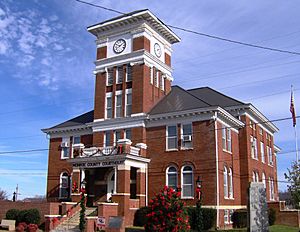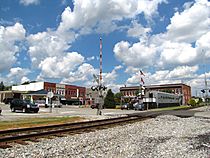Monroe County, Tennessee facts for kids
Quick facts for kids
Monroe County
|
|
|---|---|

Monroe County Courthouse in Madisonville
|
|

Location within the U.S. state of Tennessee
|
|
 Tennessee's location within the U.S. |
|
| Country | |
| State | |
| Founded | November 13, 1819 |
| Named for | James Monroe |
| Seat | Madisonville |
| Largest city | Sweetwater |
| Area | |
| • Total | 653 sq mi (1,690 km2) |
| • Land | 636 sq mi (1,650 km2) |
| • Water | 17 sq mi (40 km2) 2.6%% |
| Population
(2020)
|
|
| • Total | 46,250 |
| • Density | 70/sq mi (30/km2) |
| Time zone | UTC−5 (Eastern) |
| • Summer (DST) | UTC−4 (EDT) |
| Congressional district | 3rd |
Monroe County is a county on the eastern border of the U.S. state of Tennessee. As of the 2010 census, the population was 44,519. Its county seat is Madisonville.
Contents
History
During the 18th century, towns and villages of the Overhill Cherokee were scattered along the Little Tennessee River and Tellico River throughout Monroe County. These included Chota, Tanasi (the name source of "Tennessee") and Great Tellico, which at various times were Cherokee principal towns, as well as Citico, Toqua, Tomotley, Mialoquo, Chilhowee and Tallassee. Archaeological excavations at the Citico site suggest the area was inhabited for thousands of years before the arrival of European settlers. Artifacts uncovered from the Icehouse Bottom site near Vonore date to as early as 7500 B.C., during the Archaic period.
Fort Loudoun was built by the British in 1756 as part of an agreement with the Cherokee. After relations soured between the British and Cherokee in 1760, the Cherokee laid siege to the fort, and killed most of its garrison.
Monroe County was established in 1819 after the signing of the Calhoun Treaty, in which the Cherokee relinquished claims to lands stretching from the Little Tennessee River south to the Hiwassee River. The county was named for President James Monroe.
Some of the state's first gold mines were located in Monroe County. Placer mining took place on Coker Creek (near Tellico Plains) in the early 1830s.
Monroe County was one of the few East Tennessee counties to support secession at the outbreak of the Civil War. On June 8, 1861, the county voted in favor of Tennessee's Ordinance of Secession by a margin of 1,096 to 774.
In the early 20th century, the Babcock Lumber Company conducted extensive logging operations in the Tellico Plains area. During the same period, the Aluminum Company of America began building a string of dams along the Little Tennessee, among them Calderwood, Santeetlah and Cheoah, to power its aluminum smelting operations in nearby Alcoa. The construction of Tellico Dam by the Tennessee Valley Authority in the 1970s, although staunchly opposed by many Monroe Countians, provided a number of new economic and recreational opportunities.
Geography
According to the U.S. Census Bureau, the county has a total area of 653 square miles (1,690 km2), of which 636 square miles (1,650 km2) is land and 17 square miles (44 km2) (2.6%) is water. The Unicoi Mountains, part of the greater Blue Ridge chain, dominate the southeastern part of the county. The crest of this range marks Monroe's boundaries with the North Carolina counties, Graham and Cherokee.
The Little Tennessee River flows along Monroe County's border with Blount County to the northeast. Three artificial lakes— Tellico Lake, Chilhowee Lake and Calderwood Lake— occupy this section of the river. The Tellico River, a tributary of the Little Tennessee, drains much of the southwestern part of the county. The Bald River, noted for the scenic Bald River Falls, is a tributary of the Tellico River. Sweetwater Creek, a tributary of the Tennessee River, drains a portion of northern Monroe County.
Adjacent counties
- Loudon County (north)
- Blount County (northeast)
- Graham County, North Carolina (east)
- Cherokee County, North Carolina (southeast)
- Polk County (southwest)
- McMinn County (west)
National protected areas
- Bald River Gorge Wilderness
- Cherohala Skyway (part)
- Cherokee National Forest (part)
- Citico Creek Wilderness
State protected areas
- Fort Loudoun State Park
- Tellico Blockhouse State Historic Site
- Tellico Lake Wildlife Management Area (part)
Demographics
| Historical population | |||
|---|---|---|---|
| Census | Pop. | %± | |
| 1820 | 2,529 | — | |
| 1830 | 13,708 | 442.0% | |
| 1840 | 12,056 | −12.1% | |
| 1850 | 11,874 | −1.5% | |
| 1860 | 12,607 | 6.2% | |
| 1870 | 12,589 | −0.1% | |
| 1880 | 14,283 | 13.5% | |
| 1890 | 15,329 | 7.3% | |
| 1900 | 18,585 | 21.2% | |
| 1910 | 20,716 | 11.5% | |
| 1920 | 22,060 | 6.5% | |
| 1930 | 21,377 | −3.1% | |
| 1940 | 24,275 | 13.6% | |
| 1950 | 24,513 | 1.0% | |
| 1960 | 23,316 | −4.9% | |
| 1970 | 23,475 | 0.7% | |
| 1980 | 28,700 | 22.3% | |
| 1990 | 30,541 | 6.4% | |
| 2000 | 38,961 | 27.6% | |
| 2010 | 44,519 | 14.3% | |
| 2020 | 46,250 | 3.9% | |
| U.S. Decennial Census 1790-1960 1900-1990 1990-2000 2010-2014 |
|||
2020 census
| Race | Number | Percentage |
|---|---|---|
| White (non-Hispanic) | 41,185 | 89.05% |
| Black or African American (non-Hispanic) | 736 | 1.59% |
| Native American | 141 | 0.3% |
| Asian | 194 | 0.42% |
| Pacific Islander | 2 | 0.0% |
| Other/Mixed | 2,055 | 4.44% |
| Hispanic or Latino | 1,937 | 4.19% |
As of the 2020 United States census, there were 46,250 people, 17,987 households, and 12,847 families residing in the county.
2010 census
As of the 2010 United States Census, there were 44,519 people and 20,581 housing units residing in the county. The population density was 70.00 persons per square mile and the housing unit density was 32.36 units per square mile. The racial makeup of the county was 95.23% White, 2.14% Black or African American, 0.48% Native American, 0.39% Asian, 0.02% Pacific Islander, and 1.48% from two or more races. Those of Hispanic or Latino origins were 3.30% of the population.
Parks, forests, and natural features
A portion of the county is included in the Cherokee National Forest. The Monroe section of the forest includes two federally designated wilderness areas— Citico Creek and Bald River Gorge. The Joyce Kilmer Memorial Forest is located just across the North Carolina border to the east. The Great Smoky Mountains National Park is located just across the Blount County border to the northeast.
The Cherohala Skyway, a national scenic byway, connects Tellico Plains with Robbinsville, North Carolina. Crossing the Unicoi Mountains, the road peaks at an elevation of over 5,000 feet.
Fort Loudoun State Park is located near Vonore, and includes a replica of the 18th-century colonial Fort Loudoun. The Tellico Blockhouse site lies opposite the river from Fort Loudoun, and includes a layout of the 1790s-era blockhouse (marked by stones and posts). The Sequoyah Museum, dedicated to the Cherokee scholar, is located near Fort Loudoun.
The Lost Sea is a commercial cave located 7 miles southeast of Sweetwater in Monroe County. The underground lake for which it is named is the largest in North America. The cave tour features a ride on the lake in boats with electric motors. The lake was discovered by Ben Sands in 1905 when he was only 13 years old. In 1940, the skeletons and footprints of two Pleistocene jaguars (Panthera onca augusta) were discovered in the cave. They were excavated by George Gaylord Simpson of the American Museum.
Transportation
U.S. Route 411 runs through the center of the county and through the cities of Madisonville and Vonore. U.S. Route 11 runs through the northwester part of the county and through the center of Sweetwater. State Route 68 runs in a northwest–southeast direction through the lower half of the county, passing through Sweetwater, Madisonville, and Tellico Plains. State Route 39 connects Tellico Plains to Englewood in McMinn County. State Route 72 connects southern Vonore to Loudon. Interstate 75 is located in the extreme northeastern tip of the county west of Sweetwater, and contains two exits in Monroe County. Secondary state routes in Monroe County include State Routes 165 (Cherohala Skyway), 307, 315, 322, and 360.
The Monroe County Airport is a county-owned, public-use airport located two nautical miles (3.7 km) northwest of the central business district of Madisonville.
Communities
Cities
- Madisonville (county seat)
- Sweetwater (small part in McMinn County)
Towns
- Tellico Plains
- Vonore (partial)
Unincorporated communities
- Ballplay
- Coker Creek
- Hopewell Mill
- Hopewell Springs
- Jalapa
- Mount Vernon
Education
Monroe County Schools serves most of the county for all grades and the county for high school. Residents of Sweetwater are served by Sweetwater City Schools for elementary through junior high school.
Tennessee Meiji Gakuin High School was located in Sweetwater from 1989 to 2007.
Notable residents
- William Heiskell, post-Civil War Speaker of the Tennessee House of Representatives
- Sue K. Hicks, Scopes Trial attorney and later judge; believed to be the inspiration for the song, "A Boy Named Sue"
- Ray Jenkins, defense attorney and Senate counsel during the Army-McCarthy Hearings
- Estes Kefauver, U.S. senator
- Sharon Gail Lee, Tennessee Supreme Court justice
- Charles McClung McGhee, late 19th-century railroad tycoon
- Sequoyah, Cherokee scholar born in Tuskegee Village (near Vonore); created the Cherokee syllabary, making reading and writing in Cherokee possible.
- John C. Vaughn, Confederate brigadier general; sheriff; California Gold Rush prospector
- Mary Ware (writer) (1828–1915), poet, prose writer
- Nancy Ward, Beloved Woman and political leader of the Cherokee, born in Chota
See also
 In Spanish: Condado de Monroe (Tennessee) para niños
In Spanish: Condado de Monroe (Tennessee) para niños






